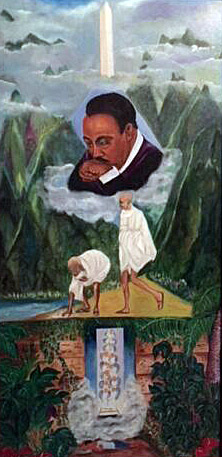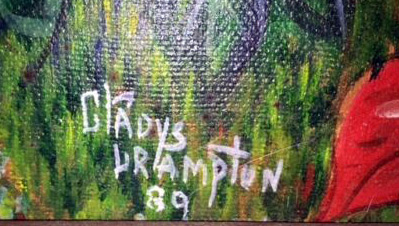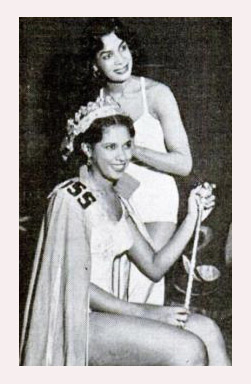My auction buddy Sly had picked up the painting at an estate sale at a house. Even in the middle of a pandemic, he can’t seem to stay home and stop buying stuff to add to the tons of merchandise he already has.
The sale was at the home of a woman who had been a dancer. Sly picked up a painting that the woman had bought from a local artist, and he wanted to know if I’d like to buy it. The buyer had passed and her son was selling her stuff. I’m a little leery about buying artwork I have not seen or handled. So I asked the artist’s name.
“Gladys Crampton,” Sly said. I’d never heard of her, but that’s not surprising. I have several local artists in my collection whose names were unfamiliar to me when I bought their works. Sly sent me a photo of an oil painting of an African American woman, her head and shoulders covered in a blue cloth and her hand holding what looked like a rope. She wore a gold ring in her right nostril.
The painting didn’t grab me but I was curious about who Gladys Crampton was. I had Googled her as soon as Sly told me her name. She was not only an artist, she also was a dancer. She and the owner of the house likely knew each other through their affinity for dance.

As a child, Crampton spent Saturdays in classes at the Philadelphia Art League and the Philadelphia Museum of Art. As an adult, she studied with Philadelphia artist Benjamin Britt, and was apparently a colleague of artist Selma Burke (who lived in Bucks County, PA, for many years). Crampton taught dance in Haiti, was named “Miss Sepia Philadelphia,” was a model in black fashion shows, and was an arts and dance teacher for the city’s Recreation Department.
She was born Gladys Emma Crampton in Philadelphia in 1931. She grew up in neighborhoods in the 1930s and 1940s with Black teachers (her mother’s family were educators) and Black churches that guided and influenced her. “At that time if someone saw you doing something wrong, they could correct you, and then you would pray that they didn’t come back home and tell your father or your parents,” she says in a 1988 interview conducted by professor Kathryn Takara for the Center for Oral History at the University of Hawaii. Crampton moved to Hawaii in 1977 for health reasons.
Sunday was always church day, and weekdays during the summer were Bible study. She didn’t mind, because she loved her church, Allen A.M.E. Church. “I always enjoyed hearing the rich Black voices singing the Negro spirituals,” she says. “It was always such a radiant energy. (I) like to sit in the church and hear the choir sing and come in with their robes, their energy and the strength that came forth from it. That was my first impression of our music and our churches.”
“I think the other strong memory is everybody made hot bread on Sunday morning in the ‘30s and the ‘40s, so you always had your breakfast (and hear) Wings Over Jordan Choir.” The Black choir could be heard nationally every Sunday morning on CBS Radio.
Crampton didn’t recollect when she started drawing. She recalled spending Saturdays in “children’s forums” at the art league and the museum. Black professional men, she noted, congregated at the Pyramid Club, founded in 1937 as a social club. In 1941, the club began holding annual art exhibits featuring Black and eventually white artists.

“In elementary school, mostly it started with modeling with clay, as I can recall it. I remember about in the fifth or sixth grade the first art lesson I remember is the lesson in actual balance. So I became very interested in design, which was just basically drawing ‘cause in elementary school, you’re not doing anything but drawing with crayons. When I started junior high school, doing posters and what have you. I won a scholarship to the Art Institute (Philadelphia Art League),” she told the interviewer.
“No one ever thought anything would come of it. … I just kept drawing and painting. I was always in my own happy world and doing it.”
She spent about 1 ½ years at Letcher’s School of Art in Washington, DC, studying commercial art, she says in the interview. I believe this was the Letcher Art Center, opened in 1949 by Henry and Evelyn Letcher. He was an artist and a Tuskegee Airman, and she was a teacher. Before Crampton’s studies were completed, she returned to Philadelphia to be with her stepmother after her father was called into the Army Reserves. A trombonist, he played in the band.
At the age of 21, someone submitted her name as a contestant in the “Miss Sepia Philadelphia” beauty competition. She wasn’t too interested, but she won the title and the $1,500 prize. A photo of her wearing the crown was featured in the Nov. 22, 1951, edition of Jet magazine. These types of beauty contests were held in several cities across the country to resemble the local and state contests of the Miss America pageant, which barred Black women.
Crampton spent several years as a model in the 1950s. It didn’t last long, she says, because she didn’t like the superficiality of people’s perceptions of models. She was modeling at a time when Black women were being hired for Black fashion shows but not for work with white commercial agencies.
During the 1960s, Crampton worked for the recreation department in Philadelphia teaching arts, arts and crafts, and dance to inner-city students. She spent the summers working out of Camp Larchwood where students and parents of all races were bused out of the confines of concrete and buildings to the natural setting of the outdoors. Meanwhile, she traveled to Africa, Haiti, Jamaica and other islands of the Caribbean, immersing herself in their cultures.
She had taken dance lessons as a child. So, in Haiti, she taught modern and jazz dance in a trade for lessons in Haitian dance at a school founded by Lavinia Williams, a former member of the Katherine Dunham Dance Company.

Around this time, Crampton also met Philadelphia artist Benjamin Britt, who took her under his wings. She worked out of his studio, in her own basement and one of her bedrooms. He “liked my work, and I began to study with him,” she says in the interview. “Then all of the energy of ‘Black is Beautiful’ came out. … Blacks became aware of their heritage. And they were proud. They were no longer ashamed of their wide noses, their thick lips, or their hair. They found out who they were. And as me working in the field of education, I wanted to have some part of helping them mold it.”
She says Britt taught her how to use color. “I like color. I like nature. I like life. And to me, that’s all what color represents,” she says.
Britt – who was a mentor to other artists – also guided her: She tells the story of how she was trying to paint bricks but was struggling. He advised her to go outside, walk along Germantown Avenue and look at the bricks. “And when I came back I felt as though I could lay bricks. … Things weren’t told to you. You were given direction,” she says.
As most African American artists, Crampton wasn’t exhibiting much. It was tough for Black artists to find places to show their works, but they did find the city’s recreation centers as one alternative. (The Pyramid Club was among the few others.) Britt was instrumental in getting her into an exhibit at Cheyney State College. She first demurred, she says, but finally relented. Afterward, her exhibits were more frequent. “Somehow or another they just thought we couldn’t paint. You saw Phillis Wheatley for the writers, yes, but painters, no. … the doors began to open after ’65.”
Crampton wanted her art to show the souls of the people she grew up with and the community that embraced her.
“I just wanted to try to depict the strengths of our culture. In a unique way that could convey a history without it being too oral,” she says. “Of course, oral opinions have a way of disguising the truths. And I try very hard with my Black artworks. No truths are ever disguised. They’re there for the viewer to see and I think this is an important means of communication because the painting can speak to the viewer, and the viewer himself can speak to the (painting). And they can walk away and they can have a different concept of what they did when they first come (to view the painting).
“As I always say, lets (everyone) know that our people are about more than tap dancing and spitting watermelon seeds.”
I could find only one other painting by Crampton via Google. In the interview, she mentioned several that were among her favorites, including a painting of her uncle Earl, a minister. She painted his robe blue, she says, because it showed the intensity of emotion in the encounter between the pastor and his church member. (Perhaps she was channeling the same in the blue fabric in Sly’s painting). Another was titled “Sister Magnesia Glow,” of an enslaved woman sitting in a white man’s kitchen near a hearth thinking pleasant thoughts. “It’s just something warm about that painting, ” she says.
Crampton died in Honolulu in 2013 at age 81.


My family and I meet Gladys during my tour of duty in Honolulu, Hawaii. We became family along with Katherine Takara. My first purchase of art was from Gladys and it hangs in our home for the past 40 years. Gladys paintings are breathtakingly beautiful and brilliant. We have at least four. We had three wonderful years with Gladys in Hawaii and stayed in touch. She truly loved art and loved it as she breathed. She was an amazing woman and artist.
Ms. Gladys Crampton was a beautiful and courageous black female artist who I met when working in the Philly Recreation Department. Gladys was a wonderful friend; I was sorry when she moved but we kept in touch. To this day, I still have on my wall an original Gladys Crampton painting.
This post is an awesome find. I have two of her paintings that have been on my family’s walls for longer than I have been alive. My dad is a Philadelphia native and made his way to Oakland, Ca in the 70’s, painting in tow. They are my absolute favorites.
Gladys and I were great friends in Honolulu. She was indeed a lovely woman whose art mirrored her personality in its brilliance and love. Before I returned to the mainland, she painted a piece for me. Just a black and white on parchment of a bamboo pod. I love it as I loved her. I am happy people have begun to discover her work.
This beautiful talented woman was my cousin. Her step-mother was my father’s sister. Irene Crampton. I grew up with Gladys and I remember how happy I was for her when she won the Miss Sepia contest. My aunt had a home in Ocean City, N. J. and from 1945 until 1955 my sister and I would vacation there from July through August. Gladys and her siblings would come down and stay for a week or two every summer. I remember when she would do drawings and when I asked her once what she was doing, she smiled and told me, just doing what I love to do. Being 10 or 11, that answer was good enough for me. Whenever she came down to the shore we would go to the beach and she was a great swimmer. She also looked really good in her bathing suit according to the stares she received. 🙂 🙂 I had no idea that one day her paintings/drawings would be so interesting. Although I have no idea if anything she did was something I once peeked over her shoulder and saw those many years ago is what others see today, I am happy to hear that what she “loved to do” has given others joy. As beautiful as she was on the outside, my cousin was just as beautiful inside. Thank you.
I too came across a painting of hers at an estate sale. Am so pleased to have come across this information, reading what a beautiful soul she was adds to the beauty of the painting.